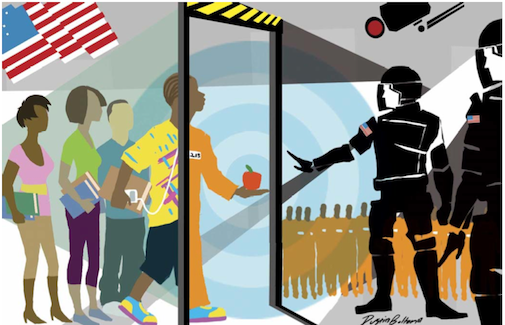Essay - Sending Teenagers to Prison Has Severe Consequences
There are nearly 60,000 incarcerated teens in US carceral system on any given day

The “school-to-prison pipeline” refers to the policies and practices that push our nation’s schoolchildren, especially our most at-risk children, out of classrooms and into the juvenile and criminal justice systems. This pipeline reflects the prioritization of incarceration over education. Though the United States has made strides in reducing its teenage prison population, it still sends thousands of youth to prison each year.
Many under-resourced schools become pipeline gateways by placing increased reliance on police rather than teachers and administrators to maintain discipline. Growing numbers of districts employ school resource officers to patrol school hallways, often with little or no training in working with youth. As a result, children are far more likely to be subject to school-based arrests, the majority of which are for non-violent offenses, such as disruptive behavior, than they were a generation ago. The rise in school-based arrests, the quickest route from the classroom to the jailhouse, most directly exemplifies the criminalization of school children.
A 2019 report by The Sentencing Project found that approximately 12,000 people in the U.S. are serving life sentences for a crime they committed before they were 18. The same study found that extensive sentences have dire psychological consequences for teenagers, hindering social, academic and emotional development.
"Sending Teenagers to Prison Has Severe Consequences" is an essay that was featured at the Prison Journalism Project. Written by Robert Schultz, an incarcerated writer in Illinois, who details his experiences growing up in prison after receiving a 45-to-85-year sentence, with no chance of parole or early release, at age 17.
Excerpts are featured below.
*****
Fyodor Dostoevsky once wrote, “The degree of civilization in a society can be judged by entering its prisons.”
Then what can be said of a society that sends teenagers to prison?
In 2009, when I was 17 years old, I got involved in gang violence and was soon charged with first-degree murder. I’ve had many family members and friends who were locked up, which led me to expect incarceration for myself. Initially, I assumed I would face 20 to 60 years and only serve half my sentence.
I was sent to an adult division of the Cook County Jail in Chicago — even though I was just a teenager at the time. Then I learned that my prediction was wrong. I was informed that I was facing a 45-to-85-year sentence to be served fully, without parole or early release. Not once during my trial and sentencing did I appear before a juvenile court or stay in a juvenile detention center. My route to prison was the same path taken by adults.
From the moment I entered the cell house, I was overwhelmed by how loud it was. Everyone was yelling over each other. It was only quiet at night, when I lay in bed and thought about all the opportunities and moments I had lost, and all the opportunities and moments I had yet to lose.
Constantly pondering these dark outcomes caused me to slip into depression for the first several months of my sentence. Every little thing began to irritate me, and I would let that irritation build to the point of combustion. There was no relief. I became a short-tempered person who reacted irrationally to small inconveniences even if they didn’t directly affect me much. This led to fights between cellmates and friction with my family.
The experience of prison at such a young age has nearly broken me. Mental scars still linger today. My lack of experiences outside of prison makes me feel insecure about my ability to be successful in a career, maintain mature relationships and have a fulfilling life after prison. I feel like I have to get all those things right on the first try because I don’t have many more chances if I fail.
It’s tough to grow up in prison. I have tried to discover and define myself among people who are years older than me. There is rarely hope for a future on the outside beyond harder, lower-paying jobs, unless I find a different path for myself. Even if I find a good job, I believe I’ll still struggle with a lack of confidence for the rest of my life because of how young I was when I received this too-long sentence. It’s challenging to talk to my family about what I’ve been through because I don’t want to scare them.
The earliest I can leave prison is 2035. I will be 43 years old. I filed for clemency in 2020 because parole doesn’t exist as an option for me. On my application, I asked the governor to consider what life I am expected to live after coming to prison as a teenager and spending the next 25 years of my life behind bars.
After all this time, once I return to the outside world, who am I supposed to be? Who does society want me to be?
*****
You can read the full essay, "Sending Teenagers to Prison Has Severe Consequences" by Robert Schultz at the Prison Journalism Project website.










